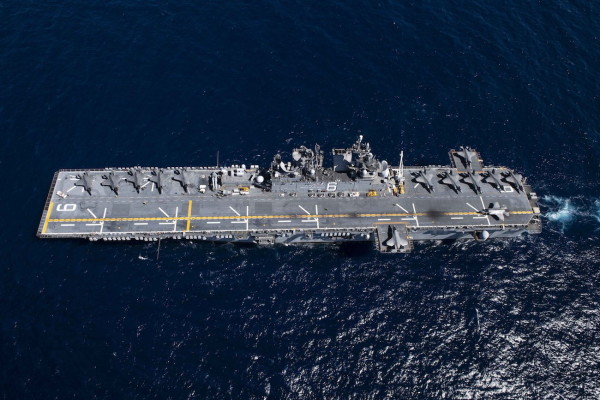

Few things say “I have come here to chew bubble gum and kick ass, and I’m all out of bubble gum” like a Navy amphibious assault craft absolutely covered with Marine Corps F-35B Lightning II joint strike fighters ready to bomb an adversary back to the Stone Age.
That’s the logic behind the so-called “Lightning Carrier” concept designed to turn those “Gator Navy” amphibs into ad hoc aircraft carriers — and the Corps appears to be moving slowly but surely into turning that concept into a new doctrine for the new era of great power competition.
The amphibious assault ship USS America (LHA-6) is currently conducting “routing operations” in the eastern Pacific as part of a effort to “refine and strengthen the fundamental amphibious capabilities” of the Navy and Marine Corps, according to the Pentagon.
But those “routine operations” apparently include a contingent of around 13 F-35Bs visible on the America’s flight deck, as our eagle-eyed friends at The War Zone point out, a slight increase over the ten aircraft spotted aboard the USS Wasp when the latter rolled through the disputed South China Sea this past April and the full dozen the USS America touted during a demonstration back in 2016.
Detailed in the Corps’s 2017 Marine Aviation Plan, the Lightning Carrier concept suggests that service could by 2025 equip all seven of its amphibious assault ships with every one of its 185 VTOL-capable F-35Bs by deploying 16 and 20 aircraft to each vessel in a variation of the “Harrier Carrier” concept utilized with the force’s AV-8B Harrier jump jets.
While the Wasp deployment was clearly a test of that concept, especially after the vessel’s Marine F-35Bs conducted the service’s first at-sea “hot reload” of ordnance by dropping munitions in quick succession on targets in the Pacific. But the next-generation America-class flattops that are “optimized for aviation capability” could end up fielding “nearly two dozen” aircraft at time, as The War Zone notes.

A possible “Lightning Carrier” configuration for the USS America (LHA-6)(U.S. Marine Corps photo)
At the moment, the Navy only has two America-class flattops out of a planned fleet of 11 at its disposal, but a full flotilla would prove a major asset beyond just building towards the service’s ambitious goal of a 355-hull fleet: namely, filling the service’s so-called “carrier gap” while the Pentagon continues to work out issues with its Ford-class aircraft carriers.
To do so, the Navy has been exploring pivoting amphibious readiness groups (ARGs) into “mini” carrier strike groups (CSGs). Indeed, the USS Essex and its ARG rolled up in the Persian Gulf last fall to perform some of the “CSG-like” functions, as Navy officials put it at the time, for the 5th fleet while the Truman carrier strike group sailed to the North Atlantic in support of NATO operations there,
“We’re definitely changing the way amphibs are employed, especially on the blue side,” Lt. Cmdr. David Mahoney, Amphibious Squadron 1 Operations Officer told USNI News at the time. “We’re no longer just the trucks that carry Marines that we used to be.”
